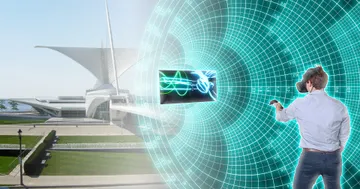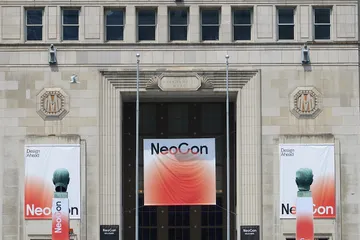For the purposes of the following illustrations, I do not intend to discuss the implications of a “general AI” (the pop-culture versions referenced in Part 1), but how “applied AI” may change how buildings are designed and how they function. While this is only a surface-level analysis of the possibilities AI might provide, the examples given below are meant to inform on innovations happening now or extrapolating how we may use technologies just around the corner.
Artificial Intelligence in Architecture: Part II
by Paul Bestul
Siri, what building is this: We now have speakers in our homes and assistants on our phones which use our voice as inputs. When a computer can understand your speech patterns, voice inflections, and conversational tones, why would you need mouse and keyboard? And since “style” is at its core a collection of unique patterns, a computer could use entire buildings as an input for reference. The program would understand fluted columns and trabeated structure as Greek. Same thing but with domes: Roman. Slender columns, pointed arches, flying buttresses: Gothic. An AI program would have access to a library of styles spanning millennia and would be able to reference these throughout the design process. Having a computer with encyclopedic knowledge of architectural history will make designing a building less like sitting at a keyboard and more like having a conversation.
Alexa, fly me to Paris: Before design begins, an architect will be able to provide a client with “virtual benchmarking tours” using AI and virtual reality in tandem. After donning the VR headsets, the users may ask a simple request to see a construction model that the architect has built for a different project. For example, asking the computer for “the atrium of the Milwaukee Art Museum” would load a fully 3D model that client and architect could virtually walk through together. The client would be able to point at an object, comment on it, and have that verbalized comment transcribed as a note within the model for future reference. Similarly, after a preliminary design is completed the client can tour the proposed solution in much the same way. This approach to design meetings would allow them to request to move a wall (or add a door, increase the ceiling height, add more lights to a space…) and see the result in real time. Time that architects spent making these adjustments after the meeting could then be used to further discuss, analyze, and improve the building’s design to the client’s satisfaction.

Cortana, build me a house: Drafting programs today assume nothing; every project starts out as a blank slate, a white sheet of paper. But buildings are often made up of programmatic blocks, and these are often functionally similar but visually different. A designer working on an ambulatory surgery center may need to model hundreds of similar bedrooms, and one working on a hospital needs to model hundreds of similar exam rooms. A substantial amount of time might be spent assembling these building-blocks before discussing how it looks or works. Further standardization is provided through building codes which regulate the size and location of many building components (like door handles and grab bars). An architect working with an AI could verify these standards and codes ahead of time, and program them as objective parameters the platform must follow. When adding a bathroom, a studio apartment, or a clinic exam room, the program would locate it in the plan where told (fully furnished) and notify the architect of any code violations. It would be quicker to produce the basic building-blocks of a design, and less rework would be needed to make sure they are code-compliant. By reducing the time it takes to conform to these requirements, AI-based drafting programs will free up the designer to focus on how people perceive and interact with the building, improving user experience and comfort.
Ok Google, follow my lead: This is not to say that the computer will design the buildings by itself; on the contrary, AI might bring back the pen-and-paper era of designing. Architects love to sketch, the generative ideas of a design are often captured first on a scrap of paper. Using VR as a sketchpad, demonstrated in the image below, an architect can now sketch in three dimensions. A future AI program might take that sketch, understand the difference between a wall and a roof, then use it to develop the preliminary model of the building. Then, wielding a stylus and tablet or motion controls, architects could design-by-hand like the master builders of Renaissance Italy: walking through a building under construction, making refinements on the spot, and watching as their sketches turn into [virtual] reality in front of their eyes. Since computer-aided design programs became the standard method of generating construction drawings, there has been a disconnect between the creative impetus of a project and its development. Subsequent programs have since aimed to make it quicker and easier to turn ideas into reality, but AI may be the tool which puts the art of construction directly back into the architect’s hands.
More images than Instagram: Architects, engineers, and contractors take thousands upon thousands of photos and hours of video to track the progress of construction. This takes a substantial investment to comb through and organize, and even then each discipline uses different programs to keep track of all the notes. For this reason, new AI-based applications are being developed to provide a single platform for construction administration. Programs like Reconstruct collect every photograph and video taken on the construction site and uses AI to stitch them together as a 3D model (similar to a cross between a Photoshop photomontage and the time-lapse function in Google Earth). Since the 3D model is made up of 2D photos and videos, clicking anywhere on the model will bring up the original image for reference. Since the AI can differentiate between solid and air, window and wall, it can also use photos taken from a similar location at different times to track progress over time. This allows the program to extrapolate how long construction will take versus how long it was expected to take. By using photos as data points, AI enables each of those photos to be added to an aggregate whole instead of them being placed in a folder, never to be seen again.
Smart Building Systems: AI will not have an impact only on how the building is designed and built, but also how it performs. One example is in healthcare facilities. Comfort is of paramount importance in the patient and staff experience of a hospital; our peer-reviewed, published research has shown that increased wellbeing throughout a patients’ stay shortens recovery time and improves perceived quality of care. AI-augmented building control systems would be able to:
- adjust the room temperature according to a patient’s monitored vital signs
- adjust the light levels to the user’s needs automatically depending on the activity in which the user is engaged (lights may dim or brighten without needing to manually adjust a switch)
- utilize network-connected sunshades with built-in sensors to adjust natural light levels and solar heat gain throughout the day
- coordinate mechanical heating and cooling systems to compensate accordingly.
Every system provides points of data based on operation and performance. The amount of data which can be collected from any building service or function is vast and is increasing exponentially the more interconnected these systems become. In the same way that a medical AI can find patterns that may have been missed in a dataset to help diagnose a patient, a building automated with AI can control every building system and continuously analyze how the interplay between those systems affect each other. “Smart buildings” will be able to fine tune themselves to be as energy efficient as possible while providing the comfort level that users expect and need.
Conclusion: One major concern about future technologies is the ability to procedurally generate entire buildings. While the trajectory of new technologies have been towards doing more with less, AI will be adopted to reduce rework and assist in communication, not to design buildings without regard for users and experience. Humans are a creative bunch: always changing and improving upon what was made before. While AI will change how a building is designed, it will not change why we design. AI in architecture will allow us to repurpose time and energy currently used to make a set of drawings and repurpose it towards exploring possibilities, more quickly iterating design options, reducing the time it takes to construct a building, and improving the experience of the users once it’s built.
Do you have any insights on the future of the AEC industry or new technologies you would like to see designers adopt? Let us know in the comments on our Facebook page or see us at a future conference on innovative technologies.


